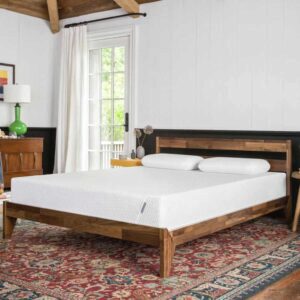Best Waterbed Mattresses
Disclosure: By clicking on the product links in this article, Mattress Nerd may receive a commission fee at no cost to you, the reader. Read full disclosure statement.
Waterbeds, sometimes called water mattresses, are said to improve health and well-being, and devotees of this mattress type tout its unique ability to provide a better sleep experience, among other benefits. Whether you’re intrigued by the idea of a waterbed as your next new mattress or already love this style, it’s important to make sure you select a model whose price point, feel, health benefits, and maintenance requirements align with your preferences and lifestyle.
In this Mattress Nerd review, we’re sharing our top picks for the best waterbed mattresses of 2025. We also share a buyer’s guide to shopping for a water mattress. You’ll learn about the types of waterbeds available today, as well as their pros and cons, important waterbed shopping considerations, and tips for choosing the right waterbed for your home.
Disclosure: By clicking on the product links in this article, Mattress Nerd may receive a commission fee at no cost to you, the reader. Read full disclosure statement.
The Best Waterbed Mattresses of 2025
- Boyd’s 98% Waveless Waterbed Mattress—Best Waterbed for Motion Isolation
- King Size Softside Pillow Waterbed Mattress —Best Softside Waterbed
- California King Free Flow Waterbed Mattress—Best Affordable Waterbed
- INNOMAX Genesis 800 Ultra Waveless Lumbar Support Waterbed Mattress—Best Hardside Waterbed
- Strobel Hydro-Support 1,400 Organic Waterbed Mattress —Best Waterbed for Back Pain
The Boyd 98% Waveless Waterbed is a hard side style designed with five layers of foam to reduce wave motion by as much as 98%. It also contains a three-layer ergonomic lumbar support system which helps provide targeted body support for the low back while alleviating pressure points, especially for stomach and back sleepers. Keep in mind that the Boyd requires a wood frame, which must be purchased separately. It comes with a 17-year warranty.
This Softside Pillow Waterbed Mattress could pass for a traditional mattress, thanks to the variety of materials in its construction and the thick pillow-top cover. You can choose from 90%, 95%, and 100% waveless models, and a free flow model is also available. The zippable cover is removable for easy machine washing. The waveless versions of this mattress are filled with contour fiber layers which both cradle the body and eliminate waves to your liking. It comes with a low-watt heating system and a 12-year warranty.
The California King Free Flow Waterbed Mattress is a hard side, semi-waveless waterbed that comes with a bottle of waterbed conditioner and a fill kit. It’s made with one thin layer of fiber for added comfort and has reinforced corners. Together, these design elements create a flat surface for sleeping that allows for minimal water movement. Buyers who purchase this waterbed from Amazon are instructed to contact the seller for details about warranty coverage (some reviewers mention a partially-prorated 12-year warranty). This hard side waterbed does not come with a frame.
The INNOMAX Genesis is a hardside waterbed that’s sold without a frame and has a waveless design. It features a thick, 24 mil vinyl cover to help prevent leaks and tears. Inside the bed is a system of four layers of foam bolsters that create excellent wave elimination and motion isolation. This is our pick for hardside waterbed because high-quality, hardside models that eliminate waves are relatively difficult to find. The INNOMAX is backed by a generous 20-year warranty.
Contrary to popular belief, most waterbeds encourage aches and pains rather than alleviate them. This is because their malleable surfaces often lack a firm surface and therefore throw sleepers’ spines out of alignment and into compromising positions. The Strobel Organic Waterbed helps solve this issue for individuals with back pain who want a waterbed by providing a “feathertop” surface that creates the sensation of “floating on” the waterbed, even if the bed is filled to a medium-firm or firm-level for healthy support. The Strobel Organic bed is a hardside model, is fire-resistant and waveless, has a lumbar support system, and features reinforced corners.
Waterbed Mattress Buying Guide
The waterbed was originally invented by a student at San Francisco State University in 1967, and although it took a while for the style to catch the interest of the general public, waterbed sales accounted for a large chunk of the American mattress market by the early ‘80s. Traditional mattresses, like innerspring, hybrid, and all-foam styles, have become more popular in recent years, but many sleepers still enjoy the unique feel that only a waterbed can offer.
In this buyer’s guide, we’re briefing you on the types of waterbeds available and sharing key shopping tips, considerations for choosing the right one, and more information to help you make an informed and confident purchase.
Types of Waterbed Mattresses
Today, waterbeds come in two primary types, hardside and softside, and each has pros and cons.
Hardside Waterbed Mattresses
This type has a water chamber that is secured inside a wooden frame. The frame is durable and heavy, helping the bed maintain some shape. Hardside waterbeds are less expensive than softside waterbeds and are the more traditional of the two types. Although the name may seem to imply that hardside waterbeds are more durable than their softside alternatives, hardside waterbeds tend to be less comfortable and less durable.
To help you picture the difference, it can be helpful to think of hardside waterbeds as a large, loose water chamber inside a wooden waterbed frame. Other than the outer frame, there isn’t much in the bed’s construction to prevent the inner water chamber from moving or creating waves, which creates a very mobile and fluid surface to the bed. Most hardside waterbeds are sold separately from their wooden frames.
Softside Waterbed Mattresses
Softside waterbeds, sometimes called soft-sided waterbeds, are the newest of the two types of waterbeds. These feature a smaller water chamber, sometimes referred to as the mattress “bladder,” that’s encased in one or several layers of foam and upholstery. This design increases durability, creates a more waveless feel, and often looks very similar to a traditional mattress. The top may be padded with additional foams or other materials for enhanced comfort and stability.
Special Considerations
Wave Level and Feel
A waterbed’s design will influence how freely the water within it can flow. Some beds have very dramatic waves whereas others are virtually waveless, and the type you choose can impact how much you enjoy the waterbed and how well the style suits your body weight and sleeping position. Both hardside and softside waterbeds can come with various wave levels, but hardside waterbeds tend to come in mostly free-flowing styles.
- Free-Flow/Full Wave—In this style, no foam bolsters or padding is used to control the water’s motion, resulting in a mattress that has noticeable waves from the water chamber.
- Semi-Waveless—Semi-waveless styles have small bolsters for wave reduction. The result is more subtle, balanced waves, but sleepers will still feel the waves throughout the night, especially if they are heavyweight or prefer combination sleeping.
- Waveless—This style of waterbed features thick bolsters, padding, or other materials that greatly control the flow of the water. You’ll feel minimal or no water movement on this style.
Budget
Much like traditional mattress styles, waterbeds vary in price depending on their brand, style (hardside or softside), and the quality of their design and materials. Softside waterbeds typically cost more than hardside waterbeds due to the addition of foams, fibers, and padding that help contain the water chamber and make the mattress’ aesthetic appear traditional.
It’s also important to note that softside mattresses can work with existing bed frames and bases, so if you’re looking to replace an existing mattress with a waterbed and plan on purchasing the same size bed, this can result in cost savings.
In general, softside beds tend to be more expensive. For perspective, most hardside waterbeds cost less than $200 (this does not account for the cost of the frame, which oftentimes is sold separately). Softside waterbeds can have price points that are more similar to traditional mattress styles and can cost anywhere from $700 to $2,000 depending on the features, size, and brand.
Adjustable Features
All waterbeds can be adjusted by the addition or removal of water. This will greatly impact the mattress’s firmness level.
Some waterbeds also come with the ability to control the temperature of the water inside. Most waterbeds have heaters for temperature control. It’s important to note that most waterbeds sleep cold, so even if you don’t sleep hot, this can be an appealing feature.
Maintenance and Repair
In general, owners of hardside waterbeds encounter more issues and leaks than those who opt for softside waterbeds. This is because the water chambers of hardside models are much less protected than the chambers of softside beds.
Other maintenance considerations to keep in mind when purchasing a waterbed are the ease of draining, storage, and patching. Some waterbeds sold online come with patch kits for leaks whereas others do not, which could mean going without a bed for a night or two while waiting on an emergency patch kit to arrive. All waterbeds must be drained for storage and filled with a hose. If you don’t have easy access to an outside hose, a waterbed may not be the right choice for you (for perspective, a king waterbed holds roughly 235 gallons of water).
Product Policies
Almost all mattresses sold online now come with free shipping, a trial period, and a warranty. Waterbeds sold online are no different, but these policies are especially important to consider for this mattress type because waterbeds are vulnerable to problems like leaks and waterbed heater failure.
Unfortunately, most waterbeds sold today do not come with a sleep trial period. This makes it essential to read the fine print of the product’s warranty to ensure defects and unexpected issues are covered. Waterbed warranties are longer than average, but the coverage that’s non-prorated for as long as possible is ideal. Non-prorated coverage simply means that, for an extended period of time, you won’t be responsible for paying any fees if the waterbed has a defect or an issue that’s covered under the warranty.
Should You Buy a Waterbed Mattress?
I’d recommend a waterbed for:
- Budget-savvy shoppers. Again, hardside beds are generally cheaper than softside beds. However, when compared to normal mattresses, waterbeds are undoubtedly the thriftier pick. Hardside beds are generally priced at around $200, while softside beds often go for around $1,000. Don’t think a waterbed is for you? Check out our list of the best budget mattresses.
- Those searching for a long-lasting mattress. While waterbeds do have a reputation for their fragility, innovations have made newer models durable enough to last you many years.
- People who are struggling with insomnia. If your general discomfort contributes to your insomnia, then a waterbed could be a good option. Generally, waterbeds allow you to shift your weight easier. This may help you get comfortable faster, which may help you become less restless and get a deeper sleep.
- Anyone who is looking for a unique feel. While that may not be a surprise, it can be one of the pros of trying out a waterbed. If you struggle with many other types of mattresses, then maybe the waterbed will offer the feel you’re looking for.
I wouldn’t recommend a waterbed for:
- Those struggling with pain. As mentioned earlier, while waterbeds have gained a reputation that they’re good for alleviating pain, this is not always the case. The support needed for someone struggling with back pain or arthritis, for example, is generally not achieved with a waterbed because of its lack of a firm surface. Some waterbeds, like the last one in our roundup, strive to change this, but on the whole, we wouldn’t recommend waterbeds for pain.
- Light sleepers, or those who share a bed. Overall, the motion isolation is poor for waterbeds. This is especially true when it comes to hardside waterbeds, because they don’t have the foam barrier to soften the “floating on an ocean” feeling. So partners don’t wake each other up in the middle of the night, and so light sleepers can get a good night’s rest on their own, I’d recommend staying away from a waterbed or selecting a waveless waterbed. You can also check out our best mattresses for couples, which has plenty of non-waterbed options to choose from.
- People searching for the easiest set-up and the lowest maintenance. One of the potential drawbacks about waterbeds is that it takes a lot longer to assemble than a normal mattress. Additionally, it’s important to keep up yearly maintenance on waterbeds by applying waterbed conditioner. If you’re after something that is easy to set up and doesn’t require a ton of TLC, check out our list of the best bed-in-a-box mattresses.
- Seniors. Especially with the ocean-like feel of a hardside waterbed, seniors might find it difficult to get on and off of the bed. And again, waterbeds are generally not the best for pain relief, which can be a huge con for anyone more prone to pain problems. If you’re looking for something that provides excellent pressure relief and eases a specific area of pain, I suggest hopping over to one of our other articles, such as Best Mattresses for Shoulder Pain.
Picking the Right Waterbed Mattress
The purchase of a waterbed should involve the consideration of features that are unique to this mattress type in addition to all the considerations of a traditional mattress purchase.
We recommend starting your search by considering your budget. This will eliminate a large portion of mattresses for the majority of shoppers since softside and hardside waterbeds fall into different price ranges. From there, consider the wave level. For example, if you wake easily in the night due to noise or your partner’s movements, a waveless option may suit you.
A third important consideration for narrowing down the best waterbeds for your home is temperature. As mentioned, waterbeds can sleep very cool. If you enjoy sleeping with heat or get cold easily, consider a bed with heat controls that will allow you to warm the mattress on command.
Conclusion
Shopping for a waterbed mattress in 2025 is easier than ever, thanks to the wide variety of styles available online. We hope this guide puts you one step closer to choosing the right waterbed for your space. Whether you opt for an investment waterbed that’s waveless and traditional in appearance or a temporary, affordable waterbed with full motion, we hope your waterbed purchase gives you a great night’s sleep for many nights to come!
RECAP: Top Rated Waterbed Mattresses
| Model | Award | Nerd Score |
| Boyd’s 98% Waveless Waterbed Mattress | Best for Motion Isolation | 4.5/5 |
| King Size Softside Pillow Waterbed Mattress | Best Softside Waterbed | 4.2/5 |
| California King Free Flow Waterbed Mattress | Best for Budget Shoppers | 4.2/5 |
| INNOMAX Genesis 800 Ultra Waveless | Best Hardside Waterbed | 4.4/5 |
| Strobel Hydro-Support 1,400 Organic | Best for Back Pain | 4.5/5 |


